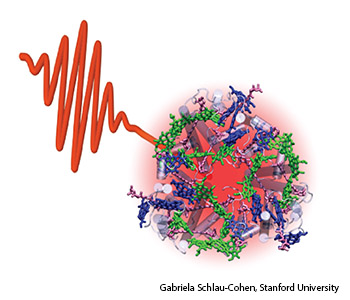
Light hitting photosynthetic antenna proteins is the first step in the light harvesting process.
Light harvesting is the first step in photosynthesis—the conversion of sunlight into biomass and one of the keys to life on Earth. Scientists have recently gained new insight into the molecular underpinnings of light harvesting and how it varies with the amount of sunlight on a given day.
Single-molecule spectroscopy has revealed that a protein found in certain purple bacteria changes into a reversible quenched state (depending on the amount of light), according to Gabriela Schlau-Cohen, a postdoctoral fellow in W.E. Moerner's group at Stanford University (U.S.A.). She presented her team’s work at the annual meeting of the Biophysical Society in San Francisco, Calif. (PNAS 110, 10899).
In light harvesting, plant proteins convert the energy from sunlight into a charge separation. Under low-light conditions, the proteins operate with almost 100 percent quantum efficiency—virtually every photon gets “used.” When sunlight is abundant, the network of proteins dissipates the energy in ways that are not fully understood.
To study the light-harvesting protein molecule, Schlau-Cohen and her colleagues suspended a single protein extracted from bacteria in a room-temperature aqueous trap, in which a time-dependent electrical field counteracts the Brownian motion of the solution. They illuminated the protein—only about 7 nm long—with lasers and observed its fluorescence through a modified confocal microscope.
The researchers found that the light-harvesting protein goes into a “quenched” conformational state when it absorbs photons and thermally reverses to the ground or “unquenched” state. The process helps to dissipate potentially harmful chemical byproducts of excess photoenergy. Protein molecules, even in the same organism, differ slightly in the details of these conformational changes, which made the mechanism difficult to understand without isolating individual units.
The next step for the Stanford-based group is exploring the light-harvesting process in higher plants—the photosynthetic powerhouses in gardens, farms and forests. Scientists hope that the understanding will help develop next-generation solar cells that can operate efficiently under varying levels of sunlight.
